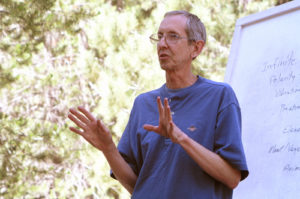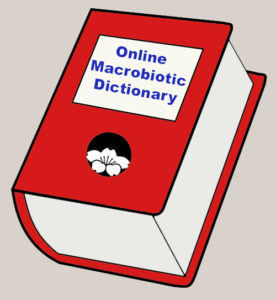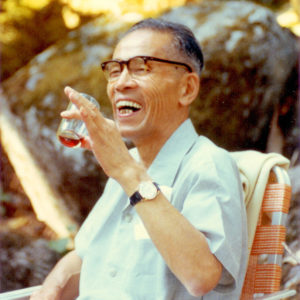
Completed Entries
Sweet rice mochi with azuki paste inside.
Long white radish (Raphanus sativus var. Longipinnatus) generally similar in shape to a large carrot used especially in Japanese and macrobiotic cuisine. Daikon is a member of the cabbage family, high in vitamin C, and considered a yin vegetable. It contains diuretics, decongestants, and several digestive enzymes. Thus, a common culinary use is grated with shoyu and a bit of grated ginger and served as a digestive aid with fish and fried or fatty foods. Daikon also is used in pickling, remedial as a tea, and topically as a plaster. The leaves are likewise used in cooking, pickling, and home remedies. Dried daikon is used in some recipes.
Water from boiled daikon used as a full bath mainly to help increase circulation and remove excess salt. Mustard powder or salt is sometimes added to further improve circulation. Grated ginger is added to help reduce fever.
See Cautionary note.
Boiled daikon greens with ginger juice added and used as a compress to help improve circulation, relieve itching, or reduce swelling or pain.
See Cautionary note.
Boiled dried daikon leaves and salt water used as a hip bath for skin diseases, bladder or anal pain, or female disorders. Grated ginger or mustard powder is added for specific disorders.
See Cautionary note.
Juice from grated daikon used as a drink for tension headaches or food poisoning. Rice syrup is added for coughing, asthma attacks, or hoarseness. Ginger is added to daikon juice with rice syrup to improve circulation.
See Cautionary note.
Juice from grated daikon massaged into the scalp to relieve headaches.
See Cautionary note.
Grated daikon radish placed on cheesecloth or wrapped in a cotton cloth and applied to the body. It is used mostly for heart diseases, flu, and bruises.
See Cautionary note.
Grated daikon mixed with grated ginger used specifically for ringworm anywhere on the body other than the head.
See Cautionary note.
The macrobiotic view is that cow’s milk is mainly for baby cows; milk and other dairy products are only consumed occasionally in small amounts as a pleasure food, if at all. Regarding yin-yang classification: “Dairy products are very difficult to place in such a classification, because some (goat milk, goat cheese, Roquefort, Edam) are very yang (about as yang as miso) and others (cream, yogurt) are very yin (about as yin as honey). Cow’s milk and most cheeses and butters are in between.” Macrobiotics: An Invitation to Health and Happiness, 78.
Soup stock made with kombu seaweed or kombu and dried fish.
Thick kombu used for making dashi, or soup stock.
Macrobiotic thinking divides life into three stages: The world of infinity, the inorganic world of things, and the organic world of physical life. Death marks the end of one’s physical life with the permanent cessation of all vital functions.
Dentie is made from charcoaled eggplant and sea salt and is used as a tooth powder. It is beneficial for pyorrhea and children’s toothaches.
Hot water and dentie powder used as a gargle for tonsillitis.
See Cautionary note.
Use of a number of techniques to determine one’s daily condition. These techniques include the seven conditions of health, physiognomy (facial and body features), and observation of eliminations. The basic idea theory based on Chinese medicine is that the outside of the body indicates the condition of the inside. Specific areas of the face, body, fingers, and toes relate to the various internal organs providing valuable information in the remedy of any disease.
One of George Ohsawa’s dietary plans in which one eats one hundred percent whole grains along with a minor amount of specific condiments for a brief period of time (three to ten days) in order to cleanse the body of excess toxins. This temporary healing diet also includes the instruction to drink as few beverages (other than water) as possible. Note: Current practice is not to restrict water in any way; each person should make certain to drink an adequate amount of water each day at all times. Note also that Diet Number Seven is not intended for long-term use.
Goals produced by a Senate Select Committee headed by George McGovern in 1977 that affirmed that Americans need to consume more grains and vegetables and less meat and sugar.
Any of several lists of percentages of various food groups that are considered to be healthy. These percentages from George Ohsawa, Michio Kushi, Herman Aihara, and others are adjusted for season, climate, location, activity, and one’s purpose.
“There is nothing identical.” This principle negates the law of identity. Even though there are countless stars in the universe and trillions of cells in one’s body, each is unique—for one thing, no two things can occupy the same space at the same time. This is the third of Seven Laws of the Order of the Universe.
See Logic, Aristotelian.
Problems or things that are hard to deal with, achieve, or comprehend. Ohsawa taught that overcoming difficulties and challenges leads to great joy and increased understanding. He maintained that the bigger or greater the difficulty, the bigger or greater the joy when it is solved.
Macrobiotics borrows this term to mean the body’s natural ability to relieve itself of internal toxins. While the body is constantly discharging toxins, this process is increased by a change in diet to foods that are free from chemicals and excessive processing. The rate of discharge is dependent on the amount of toxins and the amount and speed of dietary changes.
An incorrectly functioning organ, part, structure, or system of the body caused by excess yin, excess yang, excess extremes of both yin and yang, or other imbalance such as excess acid or alkaline. Sickness is seen as a violation or lack of understanding of the natural order of the universe. The macrobiotic approach is to find the underlying cause and to remedy that rather than just dealing with the symptoms of a disease. Symptoms are viewed as the result of sickness, not the cause. This requires a sick person to accept responsibility to study the order of the universe to determine the underlying cause of his or her disease. Excess mucus, skin problems, and painful eliminations are all signs of the body trying to rid itself of toxins.
Tao, or way.
“Dō -o is the Japanese equivalent of the Chinese word Tao, the order of nature. Raku means ‘enjoyment.’ To enjoy Tao (to live with appreciation all the time, wherever we are) is Dō-o-Raku. When we are aware of nature’s impartial and absolute justice, we know there is nothing to worry about…Interestingly, Dō-o-Raku also means ‘hobby.’ So we can say that Dō-o-Raku means to live our life as a hobby—which is what it is! Anything we do is a game. It does not matter if we ‘fail’ or ‘succeed.’ Such an understanding is Nirvana—eternal peace…To live in perpetual ecstatic delight is Dō-o-Raku. Those who do so are called Dō-o-Raku-Mono. If you are Dō-o-Raku-Mono, you are macrobiotic, whatever you eat.” Macrobiotics: An Invitation to Health and Happiness, page 88.
Wheat gluten that has been cooked with ginger and soy sauce and then dried.
The view that two substances (matter and spirit for example) are completely separate from each other. This idea is exclusive, egocentric analytical, and destructive. Dualism opposes monism—that all apparent opposites are antagonistic and complementary, and thus inclusive, generous, supportive, and accepting.
Projected Entries
Daikon radish drink #1 and #2
Daily check-up
Dairy industry
Dandelion
Dandruff
Decalcifying diseases
deLangre, Jacques and Yvette
Dental caries (see also tooth decay)
Depression
Desserts
Diabetes
Diarrhea
Diethylstilbesterol (DES)
Digitata
Disaccharide
Discernment
Disease symptoms
Disease, overlying cause
Diverticulosis
Divine medicine
Divine warning
Dō-In
Discharge
Dream
Dried tofu
Drugs
Dry-roast
Duck
Dufty, William
Dulse
Dysentery, amoebic
Dysentery, children’s
Questions or Comments?




